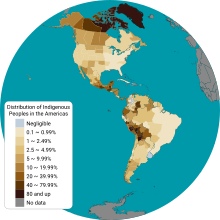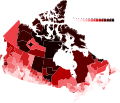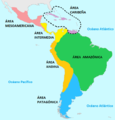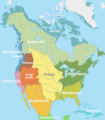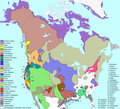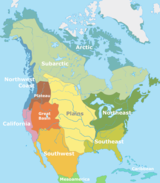
Back Portal:Etnias de América Spanish Portal:Pobos indíxenas de América Galician Portaal:Inheemse volkeren van Amerika Dutch Portal:Astecas Portuguese Портал:Индейцы Russian
The Indigenous peoples of the Americas PortalThe Indigenous peoples of the Americas are diverse groups native to a specific region, who inhabited the Americas in the pre-Columbian era, before the arrival of European settlers in the 15th century, as well as the ethnic groups who continue to identify with those peoples. These populations exhibit significant diversity; some Indigenous peoples were historically hunter-gatherers, while others practiced agriculture and aquaculture. Various Indigenous societies developed complex social structures, including pre-contact monumental architecture, organized cities, city-states, chiefdoms, states, kingdoms, republics, confederacies, and empires. These societies possessed varying levels of knowledge in fields such as engineering, architecture, mathematics, astronomy, writing, physics, medicine, agriculture, irrigation, geology, mining, metallurgy, sculpture, and goldsmithing. Indigenous peoples continue to inhabit many regions of the Americas, with significant populations in countries such as Bolivia, Canada, Chile, Colombia, Ecuador, Guatemala, Mexico, Peru, and the United States. There are at least a thousand different Indigenous languages spoken across the Americas, with 574 federally recognized tribes in the US alone. Some languages, including Quechua, Arawak, Aymara, Guaraní, Mayan, and Nahuatl, have millions of speakers and are recognized as official by governments in Bolivia, Peru, Paraguay, and Greenland. Indigenous peoples, whether residing in rural or urban areas, often maintain aspects of their cultural practices, including religion, social organization, and subsistence practices. Over time, these cultures have evolved, preserving traditional customs while adapting to modern needs. Some Indigenous groups remain relatively isolated from Western culture, with a few still considered uncontacted peoples. (Full article...) Selected article The indigenous people of the Everglades region arrived in the Florida peninsula of what is now the United States approximately 14,000 to 15,000 years ago, probably following large game. The Paleo-Indians found an arid landscape that supported plants and animals adapted to prairie and xeric scrub conditions. Large animals became extinct in Florida around 11,000 years ago. Climate changes 6,500 years ago brought a wetter landscape. The Paleo-Indians slowly adapted to the new conditions. Archaeologists call the cultures that resulted from the adaptations Archaic peoples. They were better suited for environmental changes than their ancestors, and created many tools with the resources they had. Approximately 5,000 years ago, the climate shifted again to cause the regular flooding from Lake Okeechobee that gave rise to the Everglades ecosystems. From the Archaic peoples, two major tribes emerged in the area: the Calusa and the Tequesta, who were of Taíno origin, an Arawak people, originating from the Caribbean and South America. The earliest written descriptions of these people come from Spanish explorers who sought to convert and conquer them. Although they lived in complex societies, little evidence of their existence remains today. The Calusa were more powerful in number and political structure. Their territory was centered on modern-day Ft. Myers, and extended as far north as Tampa, as far east as Lake Okeechobee, and as far south as the Keys. The Tequesta lived on the southeastern coast of the Florida peninsula around what is today Biscayne Bay and the Miami River. Both societies were well adapted to live in the various ecosystems of the Everglades regions. They often traveled through the heart of the Everglades, though they rarely lived within it. Selected imageGeneral imagesThe following are images from various Indigenous peoples of the Americas-related articles on Wikipedia.
Selected biography José de la Cruz Porfirio Díaz Mori (Spanish pronunciation: [porˈfiɾjo ˈðias]; 15 September 1830 – 2 July 1915) was a Mexican mestizo soldier and politician, who served seven terms as President of Mexico, totaling nearly three decades between 1876 and 1911. A veteran of the Reform War and the French intervention in Mexico, Díaz rose to the rank of General, leading republican troops against the French-imposed Emperor Maximilian. Seizing power in a coup in 1876, Díaz and his allies ruled Mexico for the next thirty-five years, a period known as the Porfiriato. Díaz is a controversial figure in Mexican history, with the status of villain among the revolutionaries who overthrew him, and something of a hero in the business community. The Porfiriato was marked by significant internal stability (known as the "paz porfiriana"), modernization, and economic growth. There was heavy investment in mining and railways from American and British business. However, Díaz's regime grew unpopular due to repression and political stagnation, and he fell from power during the Mexican Revolution, after he imprisoned his electoral rival and declared himself the winner of an eighth term in office. Díaz fled to France, where he died in exile four years later. Did you know…
SubcategoriesRelated portalsThings you can do
Selected panoramaTopicsRecognized content
Featured articlesFormer featured articlesGood articles
Former good articlesDid you know? articles
In the News articlesAssociated WikimediaThe following Wikimedia Foundation sister projects provide more on this subject:
American indigenous language WikipediasAvañe'ẽ (Warani) · Aymar aru (Aymara) · ᏣᎳᎩ (Cherokee) · Chahta (Choctaw) · ᐃᔨᔫ (Cree) · ᐃᓄᒃ (Inuktitut) · Iñupiak · Kalaallisut (Greenlandic Inuit) · Mvskoke (Muscogee) · Nahuatlahtolli · Diné bizaad (Navajo) · Qhichwa Simi · Tsêhesenêstsestôtse (Cheyenne) Indigenous languages in Wikimedia Incubators: Alabama · Blackfoot · Chinook Jargon · Choctaw · Creek · Lakota · Micmac · Mohawk · Nheengatu · Northwestern Ojibwa · O'odham · Shoshoni · Unami-Lenape · Wüne pakina (Mapudungun) · Yucatec Maya · Central Alaskan Yup'ik · Zuni |
